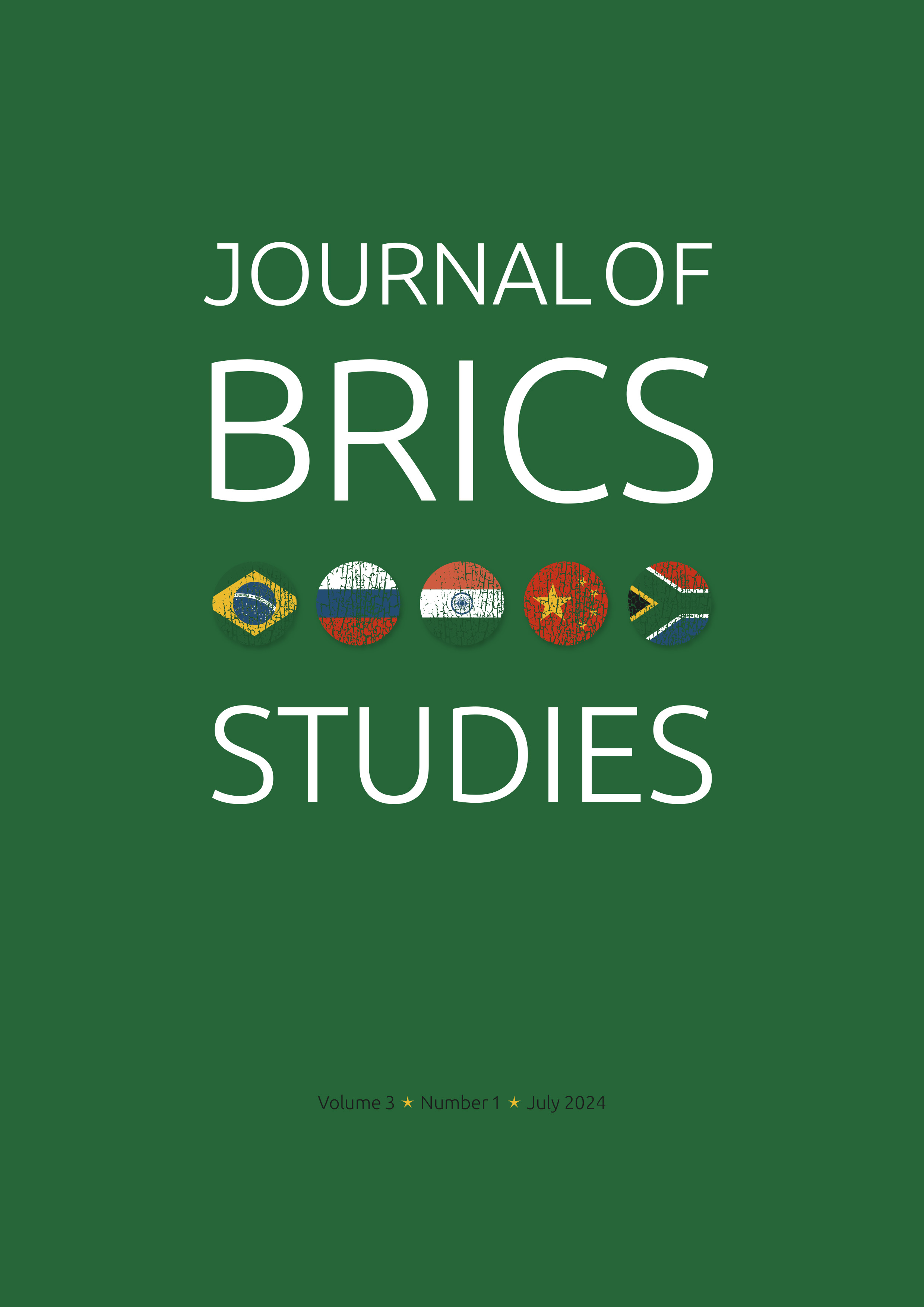Bridging the Digital Divide: Fostering STEM Education for Digital Economy Leadership
Main Article Content
Keywords
BRICS, STEM, Education, digital economy
Abstract
As BRICS countries strive to build a digital economy, these nations must prepare their populous for the ‘future of work.’ Digital economies tend to create middle to high-skilled jobs. This is problematic as many workers are trapped in low-skill occupations and lack the expertise to participate in a digital economy adequately. A digital economy requires a population that is literate in Science, Technology, Engineering, and mathematics (STEM). While BRICS has made progress in educating their populous in these fields, they still have a long way to go. More STEM graduates (especially women) must be produced to maintain and create a digital economy. This policy brief maps out strategies for BRICS countries to increase STEM participation.
Article Metrics Graph
References
Avdeenko, A., Sabirova, F., & Konyushenko, S. (2021). STEM Education: Key Challenges in the Common Practice. International Journal of Web-Based Learning and Teaching Technologies (IJWLTT), 16(6), 1-11. http://doi.org/10.4018/IJWLTT.293281
Bhattacharyya, R. (2020, January 13). STEM jobs in India increase 44% in 2016-2019, shows data. The Economic Times. https://economictimes.indiatimes.com/jobs/stem-jobs-in-india-increase-44-in-2016-2019-shows-data/articleshow/73228502.cms
BRICS digital economy report 2022 | ITC. (2022, December 12). Intracen.org; International Trade Centre. https://intracen.org/resources/publications/brics-digital-economy-2022
Buchholz, K. (2023a, March 16). Infographic: Where most students choose STEM degrees. Statista Infographics. https://www.statista.com/chart/22927/share-and-total-number-of-stem-graduates-by-country/
Buchholz, K. (2023b, March 20). Which countries are producing the most STEM graduates? World Economic Forum. https://www.weforum.org/agenda/2023/03/which-countries-students-are-getting-most-involved-in-stem/
Building communities of women digital entrepreneurs. (2021, July 1). UNCTAD. https://unctad.org/news/building-communities-women-digital-entrepreneurs
Costa, R. (2019, May 31). The role of STEM in developing countries and potential benefits. The Borgen Project. https://borgenproject.org/stem-in-developing-countries/
Han, X., & Appelbaum, R. P. (2018). China’s science, technology, engineering, and mathematics (STEM) research environment: A snapshot. PLOS ONE, 13(4), e0195347. https://doi.org/10.1371/journal.pone.0195347
Kaka, N., Madgavkar, A., Kshirsagar, A., Gupta, R., Manyika, J., Bail, K., & Gupta, S. (2019). Technology to transform a connected nation digital india. McKinsey Global Institute (MGI). https://www.mckinsey.com/~/media/mckinsey/business%20functions/mckinsey%20digital/our%20insights/digital%20india%20technology%20to%20transform%20a%20connected%20nation/digital-india-technology-to-transform-a-connected-nation-full-report.ashx
Loyalka, P., Liu, O. L., Li, G., Kardanova, E., Chirikov, I., Hu, S., Yu, N., Ma, L., Guo, F., Beteille, T., Tognatta, N., Gu, L., Ling, G., Federiakin, D., Wang, H., Khanna, S., Bhuradia, A., Shi, Z., & Li, Y. (2021). Skill levels and gains in university STEM education in china, india, russia and the united states. Nature Human Behaviour, 5(7), 892–904. https://doi.org/10.1038/s41562-021-01062-3
Machado, C., Rachter, L., Schanaider, F., & Stussi, M. (2021). Women in the STEM labour market in brazil . Gender Disparities, Career Choices, and Wage Dynamics in STEM Occupations in Brazil. https://idl-bnc-idrc.dspacedirect.org/server/api/core/bitstreams/19f5d07d-798a-4a16-8f97-25ea85d0b543/content
Magwentshu, N., Rajagopaul, A., Chui, M., & Singh, A. (2019). The future of work in south africa digitisation, productivity and job creation. McKinsey & Company. https://www.mckinsey.com/~/media/mckinsey/featured%20insights/middle%20east%20and%20africa/the%20future%20of%20work%20in%20south%20africa%20digitisation%20productivity%20and%20job%20creation/the-future-of-work-in-south-africa.pdf
Makgato, M. (2019). STEM for sustainable skills for the fourth industrial revolution: Snapshot at some TVET colleges in south africa. In K. G. Fomunyam (Ed.), www.intechopen.com. IntechOpen. https://doi.org/10.5772/intechopen.89294
Marginson , S., Tytler , R., Freeman , B., & Roberts, K. (2013). STEM: Country comparisons . Australian Council of Learned Academies. https://www.voced.edu.au/content/ngv%3A56992
Ministry of Human Resource Development. (2020). National education policy 2020 ministry of human resource development government of india. https://www.education.gov.in/sites/upload_files/mhrd/files/NEP_Final_English_0.pdf
Mkhize, Z. (2022). Is it transformation or reform? The lived experiences of african women doctoral students in STEM disciplines in south african universities. Higher Education, 86. https://doi.org/10.1007/s10734-022-00918-5
NASSCOM Research. (2020, February 7). Technology sector in india 2020 – TECHADE – the new decade strategic review. NASSCOM Community | the Official Community of Indian IT Industry. https://community.nasscom.in/communities/bpm/technology-sector-in-india-2020-techade-the-new-decade-strategic-review.html
Nzimande, Dr. B. (2022, March 22). Launch of BRICS vaccine R&D centre initiative. Launch of the BRICS Vaccine R&D Centre. https://www.gov.za/news/speeches/minister-blade-nzimande-launch-brics-vaccine-rd-centre-initiative-22-mar-2022
Oblova, I. S., Gerasimova, I. G., & Sishchuck, J. M. (2020). Gender segregation in STEM education and careers in Russia. Global Journal of Engineering Education , 22. http://www.wiete.com.au/journals/GJEE/Publish/vol22no2/09-Gerasimova-I.pdf
Odonkor, A. A. (2023, February 28). Digital technologies improve healthcare in China. Global.chinadaily.com.cn. https://global.chinadaily.com.cn/a/202302/28/WS63fdc134a31057c47ebb150c.html
Office of the President of the Russian Federation. (2019, October). Decree of the president of the russian federation on the development of artificial intelligence in the russian federation. Center for Security and Emerging Technology. https://cset.georgetown.edu/publication/decree-of-the-president-of-the-russian-federation-on-the-development-of-artificial-intelligence-in-the-russian-federation/
Qureshi, A., & Qureshi, N. (2021). Challenges and issues of STEM education. Advances in Mobile Learning Educational Research, 1(2), 146–161. https://doi.org/10.25082/amler.2021.02.009
Renn, O., Karafyllis, N., Hohlt, A., & Taube, D. (Eds.). (2015). International Science and Technology Education: Exploring Culture, Economy and Social Perceptions (1st ed.). Routledge. https://doi.org/10.4324/9781315714172
Ro, H. K., Fernandez, F., & Ramon, E. J. (2021). Gender equity in STEM in higher education. Routledge. https://doi.org/10.4324/9781003053217
Roberts, K. (n.d.). Consultant report securing australia’s future STEM: Country comparisons literature review -a selection of the work of international organizations on STEM education and stem-related issues. https://acola.org/wp-content/uploads/2018/12/Consultant-Report-International-agencies.pdf
Rothwell, J. (2013). The hidden STEM economy . Brookings. https://www.brookings.edu/wp-content/uploads/2016/06/TheHiddenSTEMEconomy610.pdf
Sikhosana, H., Hlologelo Malatji, & Aldridge Munyoro. (2023). Experiences and challenges of black women enrolled in a STEM field in a south african urban university: A qualitative study. Cogent Education, 10(2). https://doi.org/10.1080/2331186x.2023.2273646
Valente, J. A., & Almeida, M. E. B. de. (2020). Brazilian technology policies in education: History and lessons learned. Education Policy Analysis Archives, 28, 94. https://doi.org/10.14507/epaa.28.4295
Yang, X., & Gao, C. (2019). Missing women in STEM in china: An empirical study from the viewpoint of achievement motivation and gender socialization. Research in Science Education, 51. https://doi.org/10.1007/s11165-019-9833-0


